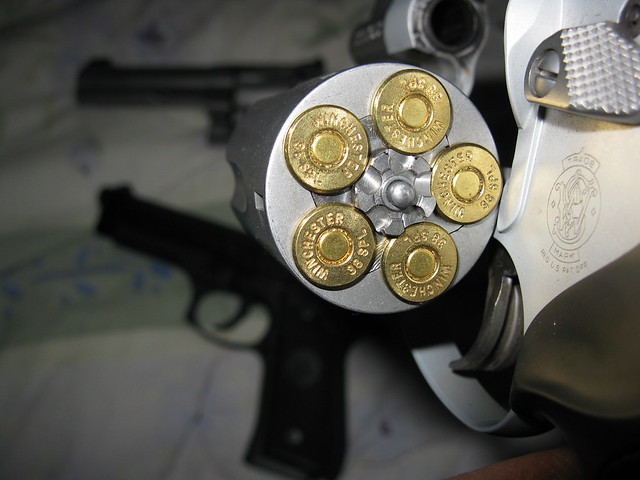 |
| Revolvers are typically chambered for rimmed cartridges. |
All breech loading guns have something known as head space. It is best illustrated in terms of a bolt action rifle. When a cartridge is placed into the gun's chamber, The bolt face (where the firing pin comes through) must seat tightly against the head of the cartridge (where the primer is). If it doesn't seat tight, the cartridge head will expand and fill this void. This not only ruins the brass, but can lead to a dangerous release of gas pressure. This would be known as excessive head space. If there is not enough head space, the bolt simply will not close.
You may also hear about a cartridge "head-spacing" on the rim or on the case mouth etc.
When a cartridge is loaded into a gun's chamber there is something that "parks"
it at a certain place. There are 3 different ways this happens.
1.) Rimmed cartridge: Some cartridges have a distinct rim at the base. Think .38 special, 44 mag, or 30-30. These cartridges are held in place by the rim. Think about putting a life preserver around your waist and jumping into a small well hole. Your legs will fit into the hole but that preserver around your waist stops you from falling all the way through. Because the cartridge "head spaces" on the rim case length is not critically important. So long as the overall length of your finished cartridge is correct, it really doesn't matter if the case length is a little short.
 |
| The cartridge on the left is rimmed, at right is rimless |
2.) Rimless auto loading cartridge: Think .45 acp, 9mm Luger, .380 acp etc. Most cartridges designed for auto pistols are of a rimless design. They do not have a rim to head space on so they head space on the case mouth. This makes case length in an auto pistol cartridge more critical. Too much case length and the gun will not go into battery. ie the slide will not go fully closed and any breech locking mechanism may not lock. Some guns will not fire in this condition, some will. Not a good situation either way.
Too short a case can also cause some feeding and extraction issues, It should also be noted that crimping any auto cartridge is undesirable for the same reasons. I used to crimp my Makarov cases just because. I never did have any feed issues, but upon examination, I could tell that the case was trying to stick in the chamber. I haven't crimped one since.
| These Mauser rounds head space on the case shoulder. |
3.) Bottleneck cartridges: Most center fire rifle cartridges do not head space on the case mouth or the rim. These bottleneck cartridges head space on the case shoulder. The chamber of the gun is reamed to fit the cartridge. When the cartridge enters the chamber, it stops when the shoulder meets the corresponding bevel cut into the chamber. That said, case length still must be observed. Cases exceeding the recommended length may prevent the bolt from closing.
4.) Belted cases: These are the odd balls. They basically use the same theory as the rimmed case, but with the added strength of a wide belt rather than just a thin rim. Belted cases, such as the 300 win mag, are also bottle necked with a shoulder, so they can use the belt or the shoulder or both to head space.
 |
| 300 Win Mag showing the belt at the base |